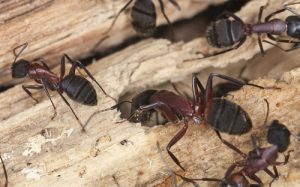Why do Carpenter ants swarm?
By Chris Williams on April 23, 2012.
With June-like temperatures once again this past week, the warm, dry weather continues to push the spring season along. Fruit bud stages (apple) are nearly three weeks ahead of normal in my orchard. The fruit trees aren’t the only things rushing ahead of schedule. I observed swarming carpenter ants for the first time this season also this past week. This occurred at one of my scheduled stops! (This was really fortunate because it showed me exactly where the nest was.) The property owner had mentioned seeing ant activity during the unusual warm stretch in March, but it had calmed down with the return to more normal temperatures. Temperature affects everything, so another burst of summer produces an ‘explosion’ of activity. Its’ not just carpenter ants, but also other pest species, like wasps that really get going with these little teases of summer. Today’s soaking rain combined with predicted cooler temps for the next several days will put a damper on things until the next bit of near summer.
 So why do the ants swarm? As carpenter ant colonies mature (6 plus years old and large enough to contain up to 2000 workers) they may begin producing ‘winged reproductive’ forms. The purpose for this unique caste is colony expansion. These winged forms represent both sexes. Male carpenter ants are very slender, and about one half inch in length (including wings). On the other hand reproductive female ants are much more ‘robust’ in size and appearance at nearly three quarters of an inch in length. Mating probably occurs outside of the colony shortly after emergence. Observation of these winged forms are often the only clue a property owner may receive of an embedded colony within a home.
So why do the ants swarm? As carpenter ant colonies mature (6 plus years old and large enough to contain up to 2000 workers) they may begin producing ‘winged reproductive’ forms. The purpose for this unique caste is colony expansion. These winged forms represent both sexes. Male carpenter ants are very slender, and about one half inch in length (including wings). On the other hand reproductive female ants are much more ‘robust’ in size and appearance at nearly three quarters of an inch in length. Mating probably occurs outside of the colony shortly after emergence. Observation of these winged forms are often the only clue a property owner may receive of an embedded colony within a home.